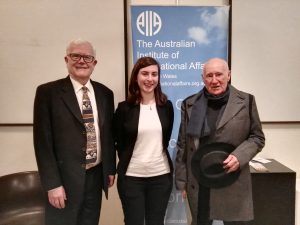The Future of Peace
As the centenary anniversary of the First World War armistice approaches, it is timely to reflect on the evolution of peace. On Tuesday 4 September, the Institute welcomed the renowned academic Dr Robert Howard, who shared his insights on the evolution of debates on peace and the prospects of peace in the 21st century.
Howard began with the literature’s finding that the period since 1945 has been the most peaceful in history. He specified that in this context peace refers to the absence of war between major powers.
Howard then analysed the main explanations for this “long peace.” Firstly, he explored the role of the UN as the legal mechanism for peace. He emphasised the historically unprecedented achievement of the UN in formalising the norm of territorial integrity and casting war as illegal except in self-defence or when approved by the Security Council. But this system was based on the assumption that the wartime cooperation between the victors, including the Soviet Union, would continue. The subsequent Cold War undermined this mechanism.
Secondly, Howard examined the influence of economic integration and modernisation on peace. He noted that trade between Great Britain and Germany did not prevent the First World War. However, he distinguished current trends of globalisation from those of the past; the Bretton Woods institutions and agreements such as GATT entrenched economic interdependence. The EU is the clearest example of economic integration promoting peace: Howard noted the historical change which has seen Europe shift from being one of the most violent regions in the world to the most peaceful.
Thirdly, Howard discussed the balance of power and nuclear deterrence as contributors to the “long peace.” However, he cautioned that nuclear deterrence only has to fail once to cause a catastrophe. Overall, Howard saw value in combining these factors. Current debate centres around whether it is the increasing costs of war or the realisation of the advantages of peace that accounts for continued major power peace.

Dr Howard (far right) with AIIA NSW intern Vicki Sideris and President Ian Lincoln
In looking to the future, Howard illustrated the danger of complacency in the face of risky trends. Recalling the optimism that many held following the end of the Cold War for a more effective Security Council, he showed how the persistence of power politics undermines cooperation. Events such as NATO’s intervention in Kosovo, the Second Gulf War and the development of the Responsibility to Protect – all of which imply legitimacy for intervening in other countries’ affairs – further muddy the assumptions underpinning the Security Council’s original post-war intent. While superpowers have avoided conflict between each other, they have failed to create a structure of peace. Had it merely been “the capitalist” (or “the democratic”) peace? Future technological advancement, anti-globalisation sentiment and the rise of identity politics are trends which further threaten the sustainability of this “long peace”.
Questions from the audience highlighted that expanding the definition of “peace” beyond just the absence of major power war also challenges the progress made in this period, for example in the Syrian War. Overall, Howard demonstrated the importance of having an historical perspective to both appreciate the achievements and understand the deficiencies of the current peace structure.
Report by Vicki Sideris,
AIIA NSW intern